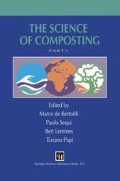Abstract
An overview of the relationship involved between climate, vegetation and soil in the Mediterranean Basin is presented. According to the criteria established by the legend of the Soil Map of the World (FAO-UNESCO, 1974 & 1988), the main characteristics of dominant soils in the area are analyzed. As well, soil problems associated to actual land uses or land uses changes are considered.
Low organic matter content is one of the common features of Mediterranean soils. Organic waste reuse through soil system for different land purposes seems to be the best way to improve soil organic matter contents. When organic wastes are composted these practices contribute to eliminate non polluted organic wastes with public health safety and environmental advantage.
Access this chapter
Tax calculation will be finalised at checkout
Purchases are for personal use only
Preview
Unable to display preview. Download preview PDF.
References
ALLAYA et al, (1988). Les échanges agro-alimentaires méditerranéens: enju mondial. In ‘Cahiers options méditerranéenes’. CIHEAM/IAMM. Montpellier. France.
CEE 1985. Soil Map of the European Communities. 1:1.000.000. Office for Official Publications of The European Communities. Luxembourg.
COCCOSSIS H.N. (1991). Historical land use changes: Mediterranean regions of Europe. In ‘Land Use Changes in Europe’ Bromer et al (ed). Kluwer Academic Publishers. NL. 441–461.
DEACON H.J. (1988). The Comperative Evolution of Mediterranean-Type Ecosystems: A Southern Perspective. In ‘Mediterranean-Type Ecosystems. The Role of Nutrients’. Kruger F.J.; Mitchell D.T.; Jarvis J.U.M. (ed) Springer-Verlag. 3–40.
DUDAL R.J.; KARAVAEVA N.A. & TARGULIAN V.O. (1990). Soil cover of the world. In ‘Global Soil Change’ Arnol et al (ed). CP-90-2. International Institute for Applied System. Austria. 31–41.
FAO & AGLS 1991. Map of the World Major Climates. World Soil Resources Map. Rome.
FAO, UNESCO 1974. Soil Map of the World. 1:5.000.000. Vol. 1. Legend. Unesco. Paris.
FAO, UNESCO & ISRIC 1988. Soil Map of the World. Revised legend. World Soil Resources Report. Roma.
GRIESBACH J.C. (1993). The Present State of Soil Resources in the Mediterranean countries. In ‘Cahiers options Méditerranéennes. Vol. 1. The Situation of Agriculture in Mediterranean countries n° 2’. CIHEAM/CCE-DG I. 9–22.
HARLAN J.R. (1992). Crops & Man. ASA, CSS A, Madison. WI.
HEKSTRA G.P. (1990). Climatic change and land use impact in Europe. In ‘Land use changes’ Kluwer Academic Publishers, 1990. NL. 177–208.
LE HOUÉROU L.H. 1990. Global Change: Population, Land-use, Vegetation in the Mediterranean Basin by the Mid-21st. Century. In ‘Greenhouse Effects, Sea Level and Drought’. Paepe R et al (ed). Kluwer Academic Publishers, pp 301–367.
LE HOUÉROU 1990. Ecological guidelines to control land degradation in European Mediterranean countries. In ‘Strategies to combat desertification in Mediterranean Europe’. Rubio J.L. & Rickson R.J. (ed). ECSC-ECC-EAEC. Luxemburg.
MANCINIF. (1964). On the elimination of the term ‘Mediterranean’ in Soil Science. Transactions of Conference on Mediterranean Soil Science. Sociedad Española de la Ciencia del Suelo. Madrid.
SÁNCHEZ-DÍAZ J. (1993). Soil-use changes in the Mediterranean Basin and its relation to chemical time bomb. In ‘Chemical Time Bomb. Delayed efects to chemicals in Soils and Sediments’. Meulen GRB et al (ed). The Foundation for Ecodevelopment. 147–156.
SKOURI M. (1993). Desertification in the Mediterranean Basin: Present State and Future Trend. In ‘Cahiers options Méditerraneennes. Vol. 1. The Situation of Agriculture in Mediterranean countries n° 2’. CIHEAM/CCE-DG I. 23–38.
SOIL SURVEY STAFF (1975). Soil Taxonomy. USDA. Soil Conservation Service. Agriculture Handbook n° 436. Washington D.C.
SZABOLCS I. (1991). Salinization potential of European Soils. In ‘Land use changes in Europe’. Brouwet et al (ed). Kluwer Academic Publishers. NL.Table 1. Main soil constrains (%) in Mediterranean countries after Griesbach 1993, from FAO World Soil Resources Map.
Author information
Authors and Affiliations
Editor information
Rights and permissions
Copyright information
© 1996 Springer Science+Business Media Dordrecht
About this chapter
Cite this chapter
Felipó, M.T. (1996). Compost as a Source of Organic Matter in Mediterranean Soils. In: de Bertoldi, M., Sequi, P., Lemmes, B., Papi, T. (eds) The Science of Composting. Springer, Dordrecht. https://doi.org/10.1007/978-94-009-1569-5_38
Download citation
DOI: https://doi.org/10.1007/978-94-009-1569-5_38
Publisher Name: Springer, Dordrecht
Print ISBN: 978-94-010-7201-4
Online ISBN: 978-94-009-1569-5
eBook Packages: Springer Book Archive

